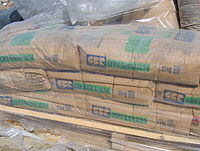
Photo from wikipedia
Objectives Hammer drills are used extensively in commercial construction for drilling into concrete for tasks including rebar installation for structural upgrades and anchor bolt installation. This drilling task can expose… Click to show full abstract
Objectives Hammer drills are used extensively in commercial construction for drilling into concrete for tasks including rebar installation for structural upgrades and anchor bolt installation. This drilling task can expose workers to respirable silica dust and noise. The aim of this pilot study was to evaluate the effects of bit wear on respirable silica dust, noise, and drilling productivity. Method Test bits were worn to three states by drilling consecutive holes to different cumulative drilling depths: 0, 780, and 1560 cm. Each state of bit wear was evaluated by three trials (nine trials total). For each trial, an automated laboratory test bench system drilled 41 holes 1.3 cm diameter, and 10 cm deep into concrete block at a rate of one hole per minute using a commercially available hammer drill and masonry bits. During each trial, dust was continuously captured by two respirable and one inhalable sampling trains and noise was sampled with a noise dosimeter. The room was thoroughly cleaned between trials. Results When comparing results for the sharp (0 cm) versus dull bit (1560 cm), the mean respirable silica increased from 0.41 to 0.74 mg m-3 in sampler 1 (P = 0.012) and from 0.41 to 0.89 mg m-3 in sampler 2 (P = 0.024); levels above the NIOSH recommended exposure limit of 0.05 mg m-3. Likewise, mean noise levels increased from 112.8 to 114.4 dBA (P < 0.00001). Drilling productivity declined with increasing wear from 10.16 to 7.76 mm s-1 (P < 0.00001). Discussion Increasing bit wear was associated with increasing respirable silica dust and noise and reduced drilling productivity. The levels of dust and noise produced by these experimental conditions would require dust capture, hearing protection, and possibly respiratory protection. The findings support the adoption of a bit replacement program by construction contractors.
Journal Title: Annals Of Work Exposures and Health
Year Published: 2017
Link to full text (if available)
Share on Social Media: Sign Up to like & get
recommendations!